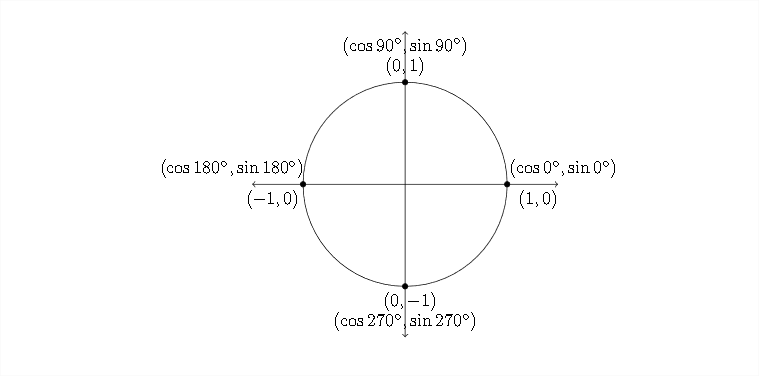3.4: More Trigonometric Equations
- Page ID
- 37222
When the solution to a trigonometric equation is one of the quadrantal angles \(\left(0^{\circ}, 90^{\circ}, 180^{\circ}, 270^{\circ} \text { and } \mathrm{so} \text { on }\right),\) then determining all the solutions between \(0^{\circ}\) and \(360^{\circ}\) can work a little differently. The calculator will return some of these values, but in some cases it may not. If we go back to the unit circle, we can see this more clearly:

In the diagram above we can see the sine and cosine for \(0^{\circ}, 90^{\circ}, 180^{\circ},\) and \(270^{\circ}\) since \(\tan \theta=\frac{\sin \theta}{\cos \theta},\) then we can see that \(\tan 0^{\circ}=0, \tan 90^{\circ}\) is undefined, \(\tan 180^{\circ}=\)
0 and \(\tan 270^{\circ}\) is also undefined.
The real issue with the quadrantal angles is finding \(\sin ^{-1}(0), \cos ^{-1}(0)\) or \(\tan ^{-1}(0)\) The calculator returns values of:
\[
\begin{array}{l}
\sin ^{-1}(0)=0^{\circ} \\
\cos ^{-1}(0)=90^{\circ} \\
\tan ^{-1}(0)=0^{\circ}
\end{array}
\]
In each case, there is another possibility than differs from the given angle by \(180^{\circ}\) so:
\[
\begin{array}{l}
\sin ^{-1}(0)=0^{\circ}, 180^{\circ} \\
\cos ^{-1}(0)=90^{\circ}, 270^{\circ} \\
\tan ^{-1}(0)=0^{\circ}, 180^{\circ}
\end{array}
\]
Let's look at how this is used in solving an equation:
Example 1
Solve the given equation for \(0^{\circ} \leq x<360^{\circ}\)
\[
\tan ^{2} x-\tan x=0
\]
We could use the quadratic formula to solve this, but we can also solve by factoring:
\[
\begin{array}{c}
\tan ^{2} x-\tan x=0 \\
\tan x(\tan x-1)=0 \\
\tan x=0 \text { or } \tan x=1
\end{array}
\]
Using a calculator to find \(\tan ^{-1}(0)\) and \(\tan ^{-1}(1)\) returns values of \(\tan ^{-1}(0)=0^{\circ}\) and \(\tan ^{-1}(1)=45^{\circ} .\) Once we know the reference angle for \(\tan ^{-1}(1),\) then we know that since the tangent is also positive in Quadrant \(\Pi I\), the solutions here are \(45^{\circ}\) and \(225^{\circ} .\) The calculator returns an answer of \(0^{\circ}\) for \(\tan ^{-1}(0),\) but we just saw that \(\tan 180^{\circ}=0\) as well.
The answers for this equation are \(x=45^{\circ}, 225^{\circ}, 0^{\circ}, 180^{\circ}\)
Another approach to solving trigonometric equations involves using Pythagorean Identities to make a substitution that so that the equation can be simply solved by the quadratic formula. Here's an example:
Example 2
Solve the given equation for \(0^{\circ} \leq x<360^{\circ}\)
\[
\sin ^{2} \theta-6 \cos \theta=4
\]
Notice that, unlike the problems we saw in the previous section, this equation involves both the sine and the cosine. To remedy this, we can replace the \(\sin ^{2} \theta\) term with the expression \(1-\cos ^{2} \theta\)
\[
\begin{array}{c}
\sin ^{2} \theta-6 \cos \theta=4 \\
1-\cos ^{2} \theta-6 \cos \theta=4 \\
0=\cos ^{2} \theta+6 \cos \theta+3
\end{array}
\]
using the quadratic formula:
\[
\cos \theta \approx-5.449,-0.5505
\]
since \(\cos ^{-1}(-5.449)\) is not a real-valued angle, we can focus on the other answer:
\(\cos ^{-1}(-0.5505) \approx 123.4^{\circ} .\) since the cosine function is also negative in the third quadrant, we need to find the reference angle that will help us identify the third quadrant angle that is a solution for this equation:
\[
180^{\circ}-123.4^{\circ}=56.6^{\circ}
\]
So the reference angle is \(56.6^{\circ}\)
\[
180^{\circ}+56.6^{\circ}=236.6^{\circ}
\]
The solutions are \(\theta \approx 123.4^{\circ}, 236.6^{\circ}\)
Example 3
Solve the given equation for \(0^{\circ} \leq x<360^{\circ}\)
\[
2 \cos ^{2} \theta-\sin \theta=\sin ^{2} \theta+1
\]
First, we'll substitute \(1-\sin ^{2} \theta\) for the \(\cos ^{2} \theta\)
\[
\begin{array}{c}
2 \cos ^{2} \theta-\sin \theta=\sin ^{2} \theta+1 \\
2\left(1-\sin ^{2} \theta\right)-\sin \theta=\sin ^{2} \theta+1 \\
2-2 \sin ^{2} \theta-\sin \theta=\sin ^{2} \theta+1 \\
0=3 \sin ^{2} \theta+\sin \theta-1
\end{array}
\]
Solving this with the quadratic formula gives us solutions of \(\sin \theta \approx-0.7676,0.43426\)
\[
\sin ^{-1}(-0.7676) \approx-50.1^{\circ}
\]
\[
\sin ^{-1}(0.43426) \approx 25.7^{\circ}
\]
We'll work with the positive solution first. since the sine is also positive in Quadrant II, the other angle will be \(180^{\circ}-25.7^{\circ}=154.3^{\circ}\)
For the negative solution, we know that the sine is negative in Quadrants III and \(\mathrm{IV},\) so with a reference angle of \(50.1^{\circ},\) in the third quadrant \(180^{\circ}+50.1^{\circ}=230.1^{\circ}\) and in the fourth quadrant \(360^{\circ}-50.1^{\circ}=309.9^{\circ}\)
The solution set is \(\theta \approx 25.7^{\circ}, 154.3^{\circ}, 230.1^{\circ}, 309.9^{\circ}\)
Exercises 3.4
Solve the given equations for \(0^{\circ} \leq x<360^{\circ}\)
1. \(\quad 9 \sin ^{2} \theta-6 \sin \theta=1\)
2. \(\quad 4 \cos ^{2} \theta+4 \cos \theta=1\)
3. \(\quad \sec ^{2} \alpha-2 \sec \alpha-3=0\)
4. \(\quad \csc ^{2} \beta+4 \csc \beta-10=0\)
5. \(\quad \csc ^{2} x+4 \csc x-7=0\)
6. \(\quad 3 \cot ^{2} x-3 \cot x-1=0\)
7. \(\quad 2 \sin ^{2} x=1-\cos x\)
8. \(\quad \cos ^{2} \alpha+4=2 \sin \alpha-3\)
9. \(\quad \cos ^{2} \beta-3 \sin \beta+2 \sin ^{2} \beta=0\)
10. \(\quad \sin ^{2} \theta=2 \cos \theta+3 \cos ^{2} \theta\)
11. \(\quad \sec ^{2} x=2 \tan x+4\)
12. \(\quad 3 \tan ^{2} x=\sec x+2\)
13. \(\quad \cos \alpha+1=2 \cos 2 \alpha\)
14. \(\quad \cos 2 x-3 \sin x-2=0\)
15. \(\quad \csc ^{2} \theta=\cot \theta+5\)
16. \(\quad \csc \theta+5=2 \cot ^{2} \theta+2\)


